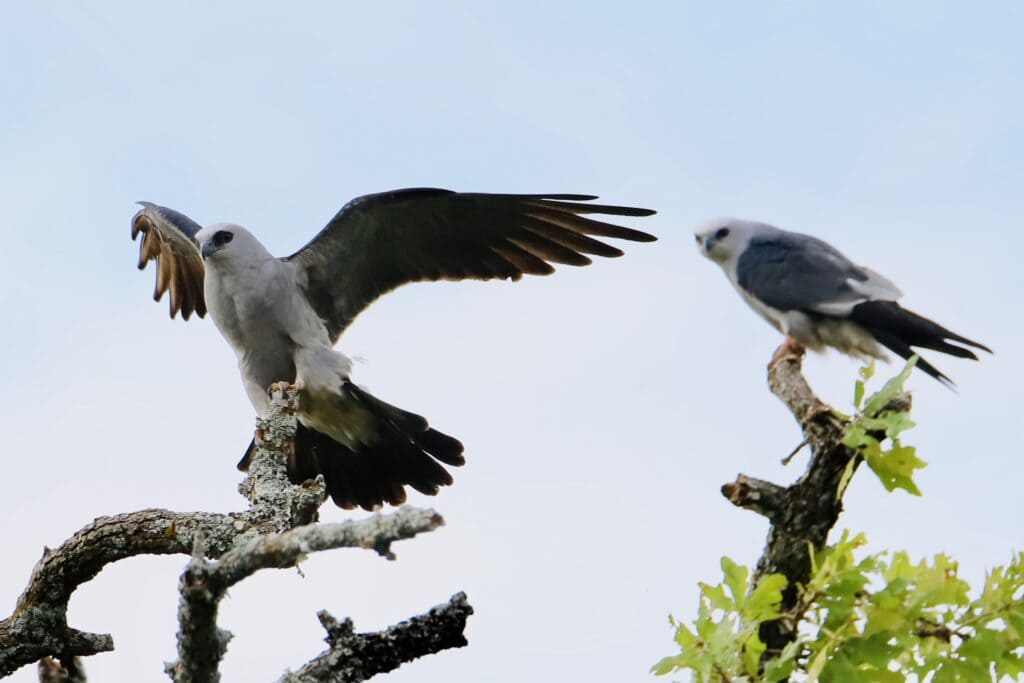Among raptors, kites have always been a favorite of mine. They are falcon-like, with small maneuverable bodies and most species have large red eyes that give them an owlish appearance. Among kites, the Mississippi Kite is a true stand out. This sleek gray member for the Accipitridae family is buoyant in the air, making it a true joy to watch from below.
Mississippi Kites are found throughout the southeastern United States, though in recent years their range seems to be expanding. They have occasionally been spotted as far west as Southern California and as far north as New England.
Related Article: Species Spotlight: The Greater Roadrunner
Fun Facts About the Mississippi Kite
Amongst raptors, the Mississippi Kite is a bit of an eccentric. This lightweight falcon plays by its own rules and many of its behaviors don’t match up with what you’d expect from a member of the Accipitridae family. Let’s look at some of the traits that make this kite so unique!
- Lighter than air: The Mississippi Kite is similar in body size to its cousin, the Peregrine Falcon. Despite their similar size, Mississippi Kites can weigh as much as three times less. This lightness allows them to float gracefully and perform truly stunning aerial acrobatics. Mississippi Kites can easily be observed swooping and diving through the sky in pursuit of insects to eat.
- Mighty migrant: When you think of migratory birds, you probably think of those spring backyard songbirds that you wait for at your feeder each year. It may come as a surprise that Mississipi Kites are migrants too! They breed in the southeastern United States and spend their winters in South America. And they’re not alone! Many diurnal raptors are migratory.
- Friend to farmers: Mississippi Kites are primarily insect eaters. They often catch bugs and eat them on the wing. This makes them a helper for farmers, as many of their preferred food items are pest insects that destroy crops.
- Pillar of the community: Mississippi Kites are unlike most other raptors in that they are highly social. They often nest in colonies, although they are content to nest by themselves. Incredibly, their nests are often the center of entire avian neighborhoods. Some Mississippi Kites build their nests on or around wasp nests, presumably as a deterrent to intruders. Northern Mockingbirds, Blue Jays, and various smaller songbirds are often found nesting near Mississippi Kites. Despite their predator status, these raptors make good neighbors and tend to co-exist peacefully with the birds that set up shop around them.
- Siblings in harmony: Speaking of social skills, it is pretty typical for raptor siblings to engage in rivalries that can have deadly results. Some species prefer to feed only the strongest offspring, ignoring younger siblings and betting on the eldest to thrive. Mississippi Kites are an exception. Mississippi Kite siblings are not hostile to each other and will even build onto the nest together and preen each other. This level of sibling sociability is an oddity amongst birds of prey.
- Parental apprentice: If stories of communities of smaller animals cropping up around them and siblings snuggling in the nest are not enough to convince you of the cooperative social nature of the Mississippi Kite, I might know what will do it. Often Mississippi Kite pairs are visited by year-old youngsters who take on the responsibility of defending the nest and brooding the eggs. Sometimes, the parents will chase off this volunteer babysitter, but they do sometimes allow their young helper to stick around.
The Future of the Mississippi Kite
Mississippi Kite populations experienced some decline in the mid-1900s, but today their populations are generally stable. The International Union for the Conservation of Nature considers them to be of “least concern” with regards to the Red List of Endangered Species. For the Mississippi Kite, the future looks promising, so long as their habitats are preserved.
Popular Article: Flock of California Condors Seen in Contra Costa County For the First Time in a Century

